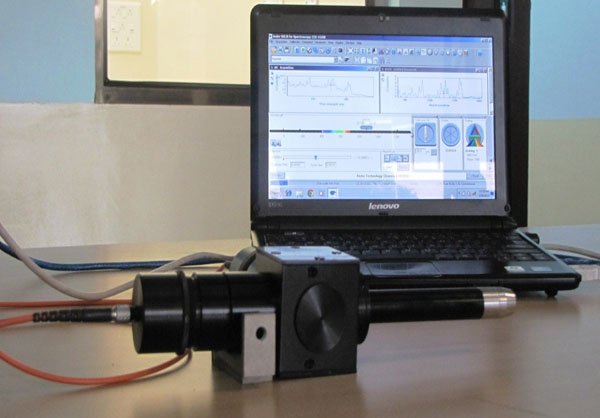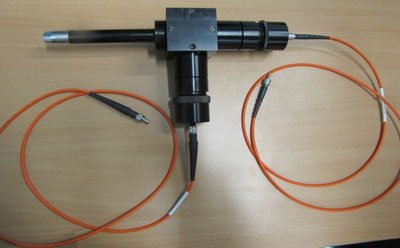Raman probe |
Overview
The Raman probe developed at RRCAT is meant for in situ measurement of good quality Raman spectra from low Raman-active materials like biological tissues. Unlike the commercially available Raman probes which are found to introduce various artefacts that interfere with the Raman signatures appearing in the fingerprint region of the tissue Raman spectra and lead to confusion in its interpretation, the developed probe is based on a novel design by which it helps avoid these artefacts. Further, the design also optimizes collection efficiency enabling in situ measurement of good-quality, artefact-free Raman spectra from biological tissues within a few seconds. The developed Raman probe is expected to further the use of Raman spectroscopy in the field of biomedical applications where in situ measurement of Raman spectra is often desired but not possible because of unavailability of a suitable Raman probe.

Quick View Leaflet
A Raman probe is an important component of a Raman spectroscopic system intended for non-invasive analyses of any Raman active material. However, the extremely weak Raman intensity of biological tissues associated with the order of magnitude larger Rayleigh background swamping the measured Raman signal makes it difficult to develop an appropriate tissue Raman probe. The developed Raman probe is based on a novel design by which it helps avoid the artifacts in the measured Raman spectra of tissues introduced by the commercially available probes. Further, the design optimizes collection efficiency, and enables measurement of good-quality, artefact-free Raman spectra from low Raman active materials within a few seconds. It is expected to facilitate use of Raman spectroscopy for biomedical applications where in-situ measurement of Raman spectra is often desired but not possible because of unavailability of a suitable Raman probe.
FEATURES
- Good quality and artefact-free Raman spectra from low Raman active samples like biological tissue.
- In-situ measurements.
- Compact probe head.
APPLICATIONS
This probe is intended for applications involving measurement of good quality Raman spectra in situ from biological samples or any Raman active samples where in-situ measurement of Raman spectra is required but not possible because of unavailability of a suitable Raman probe.
Detail Technical Brochure
The Laser Biomedical Applications Section at Raja Ramanna Centre for Advanced Technology, Indore, a unit of Department of Atomic Energy has developed a Raman probe for in situ measurement of good quality and artifact-free Raman spectra from a low Raman-active material like biological tissue. The probe comprises two arms, one for excitation and the other for collection, at right angle to each other. The spectrally purified collimated laser beam coming out of the excitation arm is steered towards the collection arm with the help of appropriate optics. For recording Raman spectra from a target sample, one needs to put the tip of the collection arm in gentle contact with the sample surface. The collected Raman scattered light from the sample is transmitted by a proper combination of optics to the distal end of the collection arm for detection. The optical design minimizes the spectral artefacts and optimizes collection efficiency, thereby enabling measurement of high-quality artefact-free Raman spectra from low Raman active materials within a few seconds.
FEATURES
- Good quality and artefact-free Raman spectra from low Raman active samples like biological tissue
- In-situ measurements
- Compact probe head
APPLICATIONS
The developed Raman probe is intended for applications involving measurement of good quality Raman spectra in situ from biological samples or any Raman active samples where in-situ measurement of Raman spectra is required but not possible because of unavailability of a suitable Raman probe
SPECIFICATIONS
| Sr. No. | Specification | Value |
| 1 | Mechanical Dimensions | Probe head diameter15 mm, length 22 cm, width 12cm, height 50 mm |
| 2 | Weight | 300gm |
| 3 | Power Input | No additional power requirement |
INFRASTRUCTURE
- Standard opto-mechanical laboratory with assembling facilities.
TEST EQUIPMENTS
- A Raman spectrometer with its entrance port fitted with SMA 905 connector, a 785 nm diode laser with the provision of optical fiber connection through a SMA 905 connector and a PC with windows xx OS.
OTHER FACILITIES
- Standard assembling facilities of opto-mechanical components like objective lenses, laser clean-up filter, notch and dichroic filter, focusing lenses and optical fibers.
SKILLED MANPOWER
- One qualified Physics Graduate/ postgraduate or an opto-mechanical engineer with sound knowledge of optics, a technical assistant with 1-2 years of experience in assembling optical instruments
POWER
- As required by the interfacing Raman spectrometer, diode laser and computer/laptop.
 |
 |
